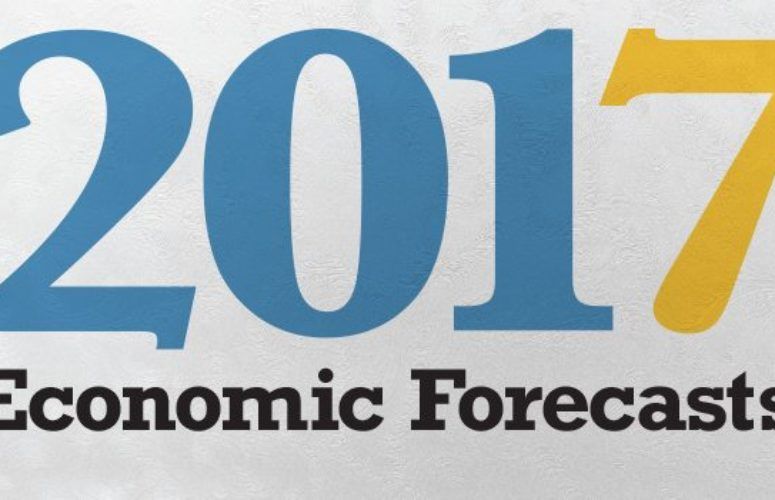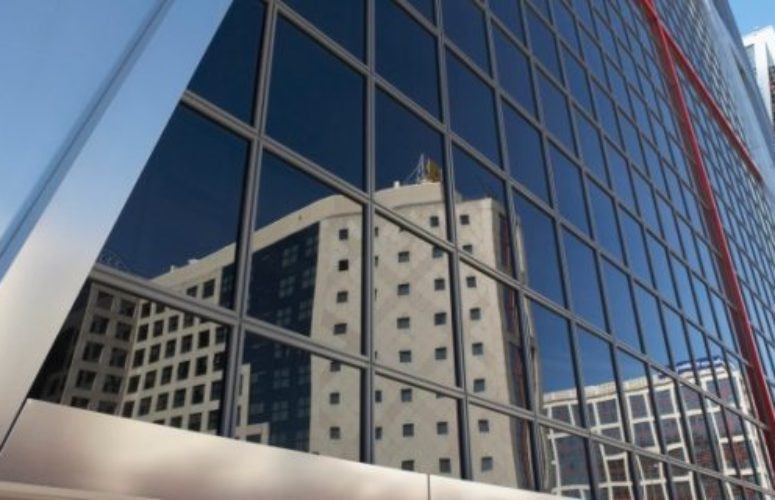
2016 Economic Forecasts
New Year Trends to Help Your Business
On Dec 28, 2015While a morass of unpredictable variables make prognostications for the year 2016 difficult, known baseline data – combined with expert analysis – can nonetheless offer insight regarding this newly-unfolding year. On the following pages, nonpareil sector professionals explore how the stock market, commercial real estate market, financial industry, energy sector and the overall economy/labor market might unfold throughout 2016. Overall, this series of by-lined feature articles provides a backdrop against which business owners/executives can glean the information necessary to help them make critical decisions this year.

James W. Hughes (left) and Joseph J. Seneca (right)
The Economy
By James W. Hughes and Joseph J. Seneca, of the Edward J. Bloustein School of Planning and Public Policy at Rutgers.
When the national expansion enters 2016, it will be halfway through its seventh year, or 78 months in length. The Great Recession (December 2007 to June 2009) continues to slip deeper and deeper into economic history, although it is still fresh in many observers’ minds. Nonetheless, the national economy will have substantial momentum as 2016 unfolds: It has experienced five straight years (2011 through 2015) of strong private-sector employment growth, averaging over 2.5 million jobs per year, a pace that exceeds that of the golden years of the late 1990s. It should be able to maintain that pace in 2016, unless global growth slows more than expected and the dollar’s increase in value is more than expected. Thus, the 2016 US economic trajectory should provide strong tail winds for New Jersey.
New York City should also provide a boost for the Garden State. The Big Apple has been the post-recession regional growth locomotive led, not by finance, but by the TAMI sectors (technology, advertising, media and information). New York’s robust employment gains have generated equally robust housing demand – and soaring shelter costs in the city. This demand has spilled over into New Jersey’s Hudson River “Gold Coast.” This has helped spur the state’s multifamily housing boom. Single-family housing’s share of new construction has fallen from the historical 75 percent level down to just 40 percent in New Jersey. Three out of five new housing units – 60 percent – are now multifamily, with a strong tilt toward rental. And the bulk of that is in northern New Jersey, mainly in the New York commutershed. Multifamily rental is now the development market driver, particularly rental near rail stations. This will be evident throughout 2016, as the dramatically changing skyline of Jersey City will attest.
The same spillover effect may start to take hold in the office sector. New Jersey has a strong competitive advantage in occupancy costs, which are soaring in New York City. Some TAMI employment growth should shift to New Jersey. Another spillover benefit from New York’s remarkable growth has accrued to the state’s large warehouse distribution sector. For example, online grocery activity in New Jersey serving the affluent Manhattan market has grown rapidly, and should continue in 2016. The same will be true for the expansion of large fulfillment centers in the state, since there are few available large parcels of vacant land that such facilities require in New York. Geography and land availability will continue to be a key New Jersey advantage in the broader region.
There is no way to sugar coat New Jersey’s lagging post-recession employment performance. However, the strengthening of the factors cited above should point to improvement in 2016. At the same time, several negatives factors that have constrained growth in the past several years in New Jersey may have mostly run their course – namely, the difficult post-monopoly resizing of Atlantic City’s casinos, the merger and acquisition activity in the state’s pharmaceutical industry, and the slow pace of post-Sandy rebuilding. But, full economic lift-off will still be constrained by the difficulties of New Jersey’s large and aging outer-suburban office markets, a development format that was cutting-edge 30 years ago, but which has now fallen out of favor.

Rasika Athawale (left) and Frank A. Felder (right)
ENERGY
By Rasika Athawale & Frank A. Felder, Center for Energy, Economic and Environmental Pollicy, Rutgers University
As was predicted, 2015 was a year of low fuel prices and action on climate change-related policies. Going ahead, state-level responses to the EPA’s Clean Power Plan, strengthening of the US dollar (along with weakening/volatility of global currencies), and unrest in oil-producing regions (especially the Middle East) shall guide the US energy sector in year 2016.
According to the OPEC Secretariat’s Monthly Oil Market Report for November 2015, global oil consumption was at 92.86 million barrels per day (mb/d, whereas the global oil supply stood at 94.13 mb/d at the end of third quarter of 2015. Per the OPEC report, US annual production is expected to fall slightly from the high of 13.60 mb/d in 2015 to 13.54 mb/d in year 2016. Experts believe that looking at past trends, low oil prices may not have a direct effect on US production, but may lead to reduced investments in new exploration, thereby bringing back the balance in demand and supply over the medium-term. Political conflicts in the Middle East may add up to the already accumulated production losses, and the OPEC Secretariat expects the regions’ oil supply to decrease by 0.03 mb/d in 2016. The US Energy Information Administration (EIA) in its Short-Term Energy Outlook (released November 10, 2015) projects the annual average gasoline retail prices to increase slightly from an average of $2.29 per gallon in October 2015 to $2.33 per gallon in 2016.
As per the EIA, natural gas inventories in the US are at an all-time high (3,929 billion cubic feet), which may bring prices down further. Compared to the natural gas price of $3.35 per MMBtu during last winter, the EIA expects a Henry Hub spot price of $2.59 per MMBtu during the coming winter season. Based on projections of a warmer winter, the natural gas inventories may stand at 1,862 billion cubic feet, thereby keeping a check on natural gas prices for the rest of 2016.
Reduction in prices and a milder winter should help consumers limit their expenditures on propane and heating oil as well as natural gas and electricity. The EIA predicts that an average household in Northeast and Midwest should experience a reduction of 14 percent and 20 percent, respectively, in propane costs. According to the National Oceanic and Atmospheric Administration (NOAA), heating degree days this winter will be 7 percent lower than the last winter, and below the 10 year average. Prices in some regions, especially the Northeast, could be volatile during the winter due to ongoing transportation constraints.
In the electricity generation industry, further shift from coal to natural gas in response to the climate policies may increase demand and therefore exert upward pressure on natural gas prices. The Clean Power Plan (CPP) final rule was announced by President Obama and the EPA on August 3, 2015, whereby standards are set for individual states to cut carbon pollution from power plants so as to achieve a cumulative reduction of 32 percent by 2030. States are expected to meet their goals by changing their generation fuel mix, installing more renewable energy and promoting even further energy efficiency investments. Several studies have been conducted predicting the effect of CPP compliance costs, which range from $2.7 Bn (Rhodium) to $33.5 Bn (NERA). Per these studies, the increase in retail rates of electricity can be as high as 13 percent due to compliance.
The EPA also proposed updates to the Cross-State Air Pollution Rule in mid-November 2015. This is expected to reduce summertime emissions of NOx from power plants, which lead to downwind ozone problems in the eastern half of the country. The proposed cuts would lead to improvements in air quality for the 2017 ozone season. Compliance to these rules may result in higher electricity costs for New Jersey residents and businesses and, at the same time, will lead to savings in healthcare related costs. EIA predicts the US retail residential electricity price for 2015 to average at 12.6 cents per kilowatt hour, which is 0.5 percent higher than the average price for 2014.
The state of New Jersey has maintained its ambition for creating a cleaner economy through legislative support such as the Energy Master Plan. The installed solar capacity in New Jersey is around 1,500 MW and the state is one of the three in US to have an installed solar capacity of more than 1 GW. Recently, two leases were awarded to build offshore wind farms off the New Jersey coast under an auction held by the Bureau of Ocean Energy Management. Reliability investments as a result of strengthening of the electric grid for severe weather conditions and integration of further capacity addition of renewable energy might lead to an increase in electric retail rates. There is a possibility that the negative change in retail prices, due to lower commodity costs, might be offset in part due to a much higher increase in reliability related expenses.
Over the coming year, various local and international factors will impact fuel prices, whereas the retail prices will be much more shaped by domestic policies on climate change and emissions reduction.

Michael G. McGuinness
Commercial Real Estate
By Michael G. McGuinness, Chief Executive Officer, NAIOP New Jersey
The headline for commercial real estate in New Jersey continues to be our hot industrial sector, where land costs and availability are keeping the supply a bit constrained.
The year 2016 looks to be much the same as 2015 in terms of new development and absorption, with rents on the rise. A significant amount of new product will be coming online that will subsequently be leased up in the following year.
The expansion of e-commerce (and consumer demand for next-day, and even same-day delivery) means the rapid movement of goods is more critical than ever. The Council on Port Performance, administered by the Port Authority of New York & New Jersey, is meeting the challenge with efficiency measures that use technology and strategically placed products and services.
Additionally, the Bayonne Bridge “Raise the Roadway” project is expected to achieve navigational clearance in late 2017 to accommodate the large Post-Panamax vessels that will have access to all of the terminals serving the Port of New York & New Jersey, once the Panama Canal expansion is complete.
Technology and the investment of capital are driving demand for smaller, more efficient building footprints, including multi-level warehouses. Many of these smaller industrial facilities are rising in in-fill areas that are closer to customers. Omni-channel retailing (a seamless shopping experience for consumers integrating web stores, mobile apps and brick-and-mortar stores) is also fueling the demand for space. Traditional stores need space for “just in time” inventory to satisfy customers who want to research and complete purchases online, then pick them up at the store an hour later, and retailers that began on the web are opening physical stores in response to customer demand.
The office market saw near-record transaction volume in 2015, especially for class A space, which made up 71 percent of the leasing activity. Overall, office rents are starting to increase, with Central New Jersey ahead of the curve, particularly the Princeton and Metro Park submarkets. Vacancy rates for class A office are particularly low in markets such as Chatham, Millburn and Short Hills, at just 6.6 percent. Rates in markets that are trending right behind are Princeton at 9.4 percent, the Hudson Waterfront at 14.2 percent, and Metro Park at 16.6 percent. Taking into account class B buildings, the statewide average is still approximately 20 percent.
Although class B buildings (about 45 percent of New Jersey’s office inventory), which are situated near mass transit and amenities and are easily available to the workforce, will continue to be prime office locations, those with high vacancy rates (termed “zombie” buildings), are weighing down rents.
The rise of the sharing economy and co-working centers could breathe new life into some of these zombie office buildings (stranded assets), representing golden opportunities for towns with forward-thinking leadership. Future job growth will look nothing like it has in the past. Carefully thought-out changes to zoning, planning and marketing will be essential to attract the employers and younger workforce needed to sustain our economy.
Multifamily housing is robust especially on the Gold Coast. Jersey City is anticipating the development of 3,000 to 4,000 units a year for the next several years. Other beneficiaries are communities near mass transit. Communities with easy access to a large consumer base will be targeted for drop-off and pick-up locations for e-commerce customers.
Since New Jersey is a home rule state, local governments must become much more engaged in business retention and expansion. The commercial real estate industry is on the front lines of economic development and has its pulse on the market trends and needs of the end users that inhabit our buildings, homes and communities. The “must-haves” are access, affordability, efficiency, convenience, accountability, timely decisions and a welcoming environment. Toward this end, public-private partnerships are an attractive, efficient and cost-effective way for cash-strapped government agencies to build the necessary infrastructure that supports economic development.
The investment climate is strong, with substantial capital in the market, with a significant amount of it being foreign. As the Chinese economy has weakened, commercial real estate properties in the United States have been the darling of Asian investors.
Location still matters, so New Jersey’s future should be bright. Our proximity to dense populations of consumers, the cultural amenities offered by nearby New York City and Philadelphia, the expansive and well-connected transportation and infrastructure systems and the recreational opportunities offered by our coastline and ski resorts are huge benefits. Unfortunately, none of this will matter unless our policy makers are able to secure long-term funding for our aging infrastructure and lower the costs of living and operating a business here. Our No. 1 priority for 2016 must be to invest in our transportation system. New Jersey has “good bones” … an enviable transportation network of rail, roads, interstates, bridges, airports, light rail and ferries. This transportation network is the lifeblood of our economy, our security and our overall health, and we cannot afford to neglect it.

Alfred J. Titone
Small Business
By Alfred J. Titone, New Jersey District Director, US Small Business Administration
For the third consecutive year, all economic indicators are pointing to steady economic growth in 2016. It may not be the economic boon that everyone is waiting for, but the steady growth is a welcome sign that the economy continues to head in the right direction.
According to a recent Kiplinger’s Economic Outlook, GDP is predicted to climb to 2.8 percent in the latter part of 2016, up from the 2.5 percent in 2015. Most economists agree that key factors like the unemployment rate will fall to 4.8 percent by November, down from the 5.0 rate we saw this past October.
Interest Rate Increase?
It bears watching, but will a slight increase in interest rates affect small business lending? Some economists believe that there will be minimal to no effect on small business growth or investment. The rate has not increased since 2006 and it is believed that many small business owners have built the increase into their operating budgets for 2016.
SBA Loan Approvals up 29 percent in 2015
The best way for the US Small Business Administration to measure how the small business economy is doing here in New Jersey is through the analysis of our loan portfolio. In 2015, we saw a record $822 million in loans approved to New Jersey small business owners. Those dollars went to more than 1,700 state small business owners. We found that 63 percent went to existing businesses, while 37 percent went to startup companies. Of the state’s 21 counties, SBA saw an increase in loan approvals in 18 of those counties – a very good sign that New Jersey’s economy is on the upswing.
More Spending in 2016
An improving economy has led to more spending, and that spending has led to investment in equipment that has spurred production and produced healthy economic growth. We believe this trend will continue to move upward in 2016. Our plan this year is to increase outreach to lenders to ensure that small businesses have greater access to capital in 2016.
Fee Reduction Extended through 2016
For the past three years, the SBA has focused on smaller loans of $150,000 or less. In fact, the average SBA loan in New Jersey was $473,000, slightly lower than the previous year’s average of $482,553. This has helped to get capital out to communities where it could make a real difference, especially to our underserved communities that use these small dollar loans more frequently. Although this program was originally slated to expire last year, we are excited to announce that it has now been extended through fiscal year 2016.
Steady Growth for 2016
Overall, small business owners will continue to see improved unemployment numbers, an uptick in GDP, benefit from lower energy costs and a slight increase in consumer confidence. With a new president taking office in 2017, it just might set the stage for a sequence of events that will continue to extend steady economic growth here at home.

John E. McWeeney, Jr.
Banking
By John E. McWeeney, Jr., President & CEO, New Jersey Bankers Association
New Jersey’s banks have enjoyed a strong performance and are well-positioned for the New Year ahead. While the most recent FDIC data available is for the period ended June 30, 2015, the trends are clear: New Jersey-headquartered institutions have experienced an increase in lending, deposits, capital and returns. As a point of reference, bank loans were up 6.3 percent year over year to $108.2 billion. Demonstrating the strength of New Jersey banks and their capacity to lend in 2016, bank deposits were up 4.3 percent to $112.1 billion and bank capital increased 7.5 percent to $18.9 billion. This arms our banks with lots of liquidity to reinvest in the form of loans to Garden State consumers and businesses.
These results were achieved in the face of significant challenges facing New Jersey’s financial institutions that include regulatory burdens, a low interest rate environment, heightened cybersecurity concerns, increased non-bank competition and New Jersey’s continuing foreclosure crisis. While bank operating performance improved despite these challenges, they were heavily contributing factors to the continued consolidation of the banking industry, both at the national and state levels. For the US, the number of banks declined to 6,348, down 161 since 2014 and down 3,556 banks since 2000. New Jersey banks dropped below 100 for the first time, hitting 97 at June 30, 2015. New Jersey has lost 55 banks since 2000, a 36 percent decline. Whether the consolidation levels off remains to be seen. If Washington approves some sensible and much-needed regulatory reform, especially for smaller community banks, we’ll see the level of consolidation slow. If not, it will continue at the current pace.
Arguably the greatest challenge and, for that matter, the greatest opportunity that banks face is the fight that’s now under way for financial services customers. The convergence of changing demographics, technological advances and new entrants into the financial services marketplace have put banking’s greatest asset, its customers, into play. Billions of dollars are being invested each year into new financial technology in an effort towards winning the Millennials before banks even know what hit them. We see it already with the preponderance of direct access, online consumer and small business credit options offered by competitors outside of our banking system that don’t have the same regulatory burden that banks have. Millennials now represent the largest demographic group and with Baby Boomers retiring at the rate of 10,000 per day, the economic power of the Millennials will only continue to grow. While Baby Boomers will continue to hold a lot of wealth and be profitable bank customers, it’s the Millennials that will shape how financial services are offered in the future. Just as Millennials have changed the dynamic for residential real estate from suburban home ownership to urban rentals or condos, so too will they change the banking market.
Put all of these variables together and 2016 looks like another year of challenges, changes and opportunities for New Jersey banks. I believe they’ll perform well and New Jersey will be the better for it.

Michael A. Flower
The Stock Market
By Michael A. Flower, CFP – Managing Partner, Financial Principles, LLC
Each year, we get to the beginning of the New Year and wonder: What does the stock market have in store for us? The abundant market information makes it difficult to discern where we are going and what to expect. We like to look at the markets in several different ways when making investment decisions today. We view the fundamentals, academics and one’s own personal situation.
We see many challenges and hurdles for the market in the upcoming year – slowdown of China’s economy, rising tensions in the Middle East, rate increases in the US, while a number of economies in Europe and Asia are easing their monetary policies. Let’s take a step back and review some basic information.
The housing recovery continues to improve. Housing starts, sales and permits create many jobs in the US and strengthen the base of our economy. GDP, which represents the total economic activity in the US, has been positive and healthy. The job market is strengthening and jobless claims are falling. Finally, inflation has remained low, and we expect to see a rate increase by the Fed. While the rate increase most likely will push the equity markets down temporarily, the fact of an increase is a sign of strength. The bottom line is that the news most often heard is negative and alarming. When we examine the entire picture, we discover a composite of positive and negative.
Whether the market moves up or down in 2016 should not alter one’s personal situation. Any investment plan needs to have a long-term horizon. A 30 year old and a 70 year old both have long time horizons. However, their plans bear different goals, objectives and risk. If we pay attention to the frightening news each day and change plans based upon the negative news, a mistake will be made. That is why we have an investment plan. Logic plays a critical role in creating the plan. Logic’s nemesis is emotion.
In summary, the market will face many obstacles in 2016. We also believe that volatility will continue. In 2015, we had our first correction in 3½ years. The market lost 11 percent in seven days in the month of August. Nonetheless, the market rebounded by year end. Most of us forgot that corrections happen about once per year.
When we take a moment to sort through the good and the bad, we see more good than bad at the outset of 2016. With the New Year upon us, one should take the opportunity to review his or her investment plan to make sure it is representative of one’s goals, objectives and risk. The plan will be a guide through the bumps in the road and keep one on target.

Sarah M. Adelman
Healthcare Costs
By Sarah M. Adelman, Vice President, New Jersey Association of Health Plans
Since the passage of the Affordable Care Act (ACA), each year has brought changes to the health insurance marketplace in New Jersey and across the country. We were expecting 2016 to be a disruptive year for some employers because of a provision in the ACA that would have expanded New Jersey’s small group health insurance market (currently 1-50 FTEs) to include large groups with 51-100 FTEs. This would have resulted in cancelled plans and new benefit requirements for affected employers. However, in a rare bipartisan move, Congress and the president rescinded this ACA requirement in the fall.
With this major shift off the table, employers can expect trend-level premium increases in 2016 as a result of the underlying growth in healthcare costs. Hospital costs remain the largest portion of underlying medical spend, while prescription drug costs are growing at the highest rate. More than half-a-million Americans now take at least $50,000 worth of prescription drugs each year. Meanwhile, specialty drugs comprise one percent of prescriptions written, but 32 percent of total drug spending. These pricing pressures are unsustainable and continue to drive up health insurance premiums every year.
As we consider the impact of these major cost-drivers, employers should be mindful that beginning in 2018, the “Cadillac Tax” will impose a 40 percent excise tax on higher-cost individual and family policies. The Cadillac tax serves two key functions: to generate funding for subsidies in the ACA’s individual marketplace, and to incentivize employers and employees to move away from costly plans to consumer-directed plans which often have lower costs and higher deductibles. The tax will apply to all individual policies with premiums costing $10,200 or more and family plans costing $27,500 or more. If your premium costs meet or exceed the threshold, you may want to consider alternatives to avoid triggering the tax. The excise tax also applies to government plans, and the New Jersey Pension and Health Benefits Study Commission has projected that the tax will increase the State Health Programs’ costs by an additional $58 million in FY2018, rising to $284 million by FY2022.
Health plans are offering a number of innovative solutions to help employers lower premium costs and avoid the “Cadillac Tax.” Among those solutions are high-value, preferred provider arrangements, sometimes called “tiered networks.” These networks offer broad access to all healthcare services and provider types, while creating lower cost-sharing options when a consumer selects a high-value or preferred-tier provider with lower premiums. Health plans also continue to partner with providers and hospitals to form Accountable Care Organizations and Patient Centered Medical Home programs that help bend the cost curve through quality and outcome-based financial incentives.
Affordability continues to be the greatest barrier to access to care in the post-ACA world; there is great hope that these innovations can flourish to help improve quality and contain costs.
Related Articles:






